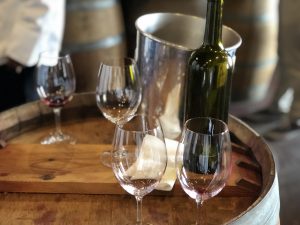The wine blending process was one that seemed to be easy at first glance but upon tasting your blend you are left uterrly opinionated. On October 1, our class revisited Red Hook Winery in order to make the wine blends we decided on a week ago with our partners. The blending process involved putting the various wines in different containers, in which we would pull a certain amount from those various wine containers and mix a desired amount from either 2 or 3 of those wines and making a blend. The blend my partner and I chose was a 75%/25% of Chardonnay to Riesling and again a 75%/25% of Riesling to Chardonnay. The result of this was us enjoying the blend of 75/25 Riesling to Chardonnay due to its light and crisp taste that doesn’t overwhelm the palate. The blend would pair well with our dish however we chose to venture further; trying blends of up to 3 different wines.
The result of the blend was much more fulfilling than the last. We made a blend of 50% Riesling, 25% Chardonnay, and 25% Sauvignon Blanc. This was it! The smell was intense and it left us curious and trying to pick part all the things that made this blend special to us. The crisp taste of apple and green pepper and the smell of flint almost like you were walking in a dry forest surrounded by various plants and earth. The strong smell of white flowers and a light zing on ginger hits you and it’s hard to distinguish the other tastes but there was definitely one thing that stood out. A berry, the berry was hiding but also trying to make its prescence known; gooseberry. The wine had medium alcohol on the nose however on the palate it was medium minus, it’s acidic notes are from citric fruits such as lemons and with a little hint of white pepper. This wine was complex and we both agreed almost immediately upon our deduction. My only regret, I wasn’t able to blend it and take it with me.




